Introduction
Our Oxford University Press book, ‘Sustaining Life: How Human Health Depends on Biodiversity’, which was published in 2008, described examples of how our health and lives are affected when we damage the living world (1). I am increasingly alarmed at the current accelerated pace and magnitude of our damaging the global environment, and how little policy-makers and the public seem to recognize this. I am particularly concerned that it is so difficult for most people to grasp what is happening to our small planet, what is happening by our own hands.
The goal of this text is to make the case that a medical decision-making model can help policy-makers and the public better understand what is at stake with our altering global physical, chemical, and biological systems, so that we can slow down and reverse some of these changes before they get out of control. I will describe the human health consequences from global warming and those changes in global climate that result from this warming. I will do so in the context of my main area of study, the loss of species and the disruption of ecosystems like forests and coral reefs.
I was delighted to present this material to the Massachusetts Land Conservation Trusts and Environmental Agencies (see Acknowledgments), not only because they hold the future of land conservation and environmental protection in the Commonwealth in their hands, but because I owe a large and unpayable debt to the Harvard Forest, as it led my wife and myself, about 2 decades ago, to decide to buy our 18th Century farm in Petersham. We had been looking for a place to buy in the country and were driving around southern New Hampshire and Maine in this quest, when a former professor of mine insisted that we take a walk in the Forest. It was late February of 1994, and it was cold. There was still snow on the ground. As we were walking, we heard a loud cacophony of birds, but we could not figure out what was happening until we came to a clearing in the forest, where there were a large number of chickadees all sunning themselves, all chattering at once, maybe more than a hundred of them. You may know what an enormous resonating racket they can make—it must have been the annual meeting of the Worcester County Chickadee Society. If there was ever a clearer message, with the suns rays shining through from the heavens and all these chickadees saying to us in unison “THIS IS THE PLACE TO LIVE” I don’t know what it is. After our walk we sought out some realtors in town and eventually were shown a property we fell in love with and the rest is history.
I have been grateful to chickadees ever since and I try to keep them well fed. But a word here about chickadees, as they provide a great example of what I will be describing in this text, that Nature has invaluable lessons to teach us and that we damage it to our peril. In the fall, the Black-capped chickadee roams a territory of tens of square miles, gathering seeds and storing them in hundreds of hiding places, in trees and on the ground. Over the winter, it visits its huge number of caches, demonstrating a memory that is truly extraordinary, even by human standards. I can’t remember most of the time where I put my reading glasses. We must never use the term “bird brain” again.
What is remarkable here is that each fall, the area of the chickadee brain responsible for laying down new memories, the hippocampus, grows in volume by some 30%. In the spring, this region shrinks back to its normal size. It was found that the chickadee, and other birds like canaries, make new nerve cells in their brains when they need them, a process called neurogenesis, and this research paved the way for our learning that human beings, and perhaps all vertebrates, and all invertebrates that have brains as well, are producing new nerve cells all the time. This discovery of neurogenesis, which was first observed in birds, totally contradicted the long held belief, which I was taught as gospel while in medical school in the mid 1960s, that we start losing brain nerve cells in our 20s and spend the rest of our lives losing them at an increasingly rapid clip, never producing any more as we age. It turns out that is not true at all. There is, by the way, a human correlate to the chickadee story—London taxi cab drivers also increase the size of their hippocampuses through neurogenesis when they are trying to find their way among London’s 25,000 streets and thousands of places of interest, and then their brains shrink back to normal size after they retire.
Why do man-made changes to the global environment appear so complicated and abstract?
In 1980, with three other Harvard faculty members, I started an organization called the International Physicians for the Prevention of Nuclear War, which eventually included some 80 national organizations of physicians around the world. In 1985, we won the Nobel Peace Prize (Figure 1). The most important contribution of the tens of thousands of physicians who were eventually part of this federation was to help people grasp what a nuclear war would really be like, so that they knew that these weapons were so catastrophically destructive they could not be used in wartime, and so that policy-makers and the public would do everything in their power to prevent a nuclear war from occurring.
Figure 1.
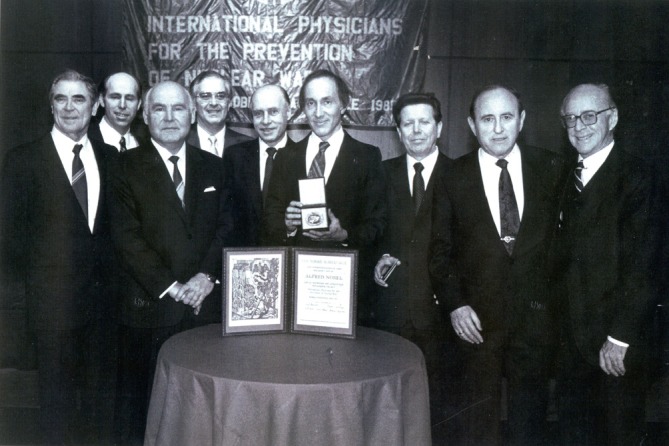
Nobel Peace Prize. Eric Chivian holding the prize (© International Physicians for the Prevention of Nuclear War)
We did this by translating the abstract, technical science of nuclear weapons explosions, that world-class scientists had been talking about and warning about for decades, into the concrete, personal terms of human health, into everyday language that people could relate to and understand—namely what would really happen to us in such a war. We talked about skull fractures instead of the number of joules of force in the explosion, about 3rd degree burns instead of the number of degrees centigrade in the fireball, and about radiation sickness instead of the number of rems of radiation in the fallout. And, as a result of these concrete stories, I believe we helped make nuclear war more real for people, we made it harder for them to think about such wars in vague, abstract, technical terms, and in the process, I believe, we helped change public opinion and indeed maybe even public policy about the use of these weapons. That was why, in addition to our bringing physicians from the Soviet Union and the US and their allies together at the height of the cold war, we won the Nobel Peace Prize.
However, in contrast to nuclear weapons explosions, changes to the global environment like climate change and the loss of biological diversity are much harder to grasp. We have no Hiroshimas or Nagasakis to serve as models, to be concrete examples of what will happen.
Global environmental changes, unlike explosions, can also be very hard to see—they often occur slowly or intermittently, sometimes almost imperceptibly, and on global scales, and they can be obscured by normal fluctuations in things like temperatures or rainfall, which are changing naturally and often abruptly and with large swings all the time. Our brains are wired to see what is happening right in front of us right now—we do not do very well with seeing things that are not obvious, that happen incrementally, or that occur over large areas or in other parts of the world.
It is very hard, for example, for us to grasp the meaning of concepts like average global temperatures. When we hear scientists say that the surface of the planet has warmed on average by about 1.8 degrees Fahrenheit since 1850, the date when humanity started burning fossil fuels on a large scale, and that scientists are beside themselves with worry that the Earth may warm by an additional 8 or more degrees by the end of this century, or close to 10 degrees warming in all if we do not change our ways, it is hard for many of us to be terribly concerned about this. What can be the significance of a 10 degree change, when we are used to more dramatic short-term fluctuations locally all the time? For example, just days after a blizzard in February dumped almost 25 inches of snow on Boston, the temperature rose to almost 50 degree Fahrenheit. Our experience with temperatures is very local, very immediate. To help put into perspective what an average warming of the Earth of 10 degrees F. really means, let us go back in time to the end of the last Ice Age, some 18,000 years ago. At that time, when the average temperatures of the Earth’s surface were only about 10 degrees cooler than they are now, there was a layer of ice on top of Massachusetts that was more than one mile thick and the Atlantic Ocean was 400 feet lower than it is now.
However, if we look around us, we can see large changes in the climate in a very short time. When we first bought our house in Petersham in 1994, there were frequent times in the winter when temperatures hit 15 degrees below zero. It has been several years since this has happened. We were squarely in hardiness zone 5 in the early 90s, now we are pretty squarely in the warmer zone 6. That is a problem on several levels—for example, warmer winters make possible the spread into our region of the Hemlock Wooly Adelgid, a scale insect that kills hemlock trees, a vitally important tree in our forests as you all know, an insect that is itself killed by very cold winters. The unusually dry and warm winter and early spring of 2012 also took its toll. On our property, we lost some 80-100 year old ash trees this past year that had been fully leafed out the year before, and the apple crop, for those of us who grow fruit, was the worst in memory. My friend Jim French, who runs his 150 tree apple orchard harvested close to 41,000 apples in 2011. This past year he had 7!
The task of grasping changes to the global environment is also made more difficult:
❖ Because there is such a fundamental misunderstanding that many, if not most, people have about the environment—believing that we human beings are somehow separate from it, that it exists outside of us. This is true even for some environmental groups, which talk a lot about wolves and whales and rainforests, but not very much about their relationship to human beings. And so, as a result, many people are not terribly worried about our degrading the atmosphere, or the oceans, or the soils, as if these changes will have little to no effect on them whatsoever, almost as if they were happening someplace other than where we all live.
❖ Understanding what is happening to the environment is also hard for many people, because scientists often speak to policy-makers and the public in technical, jargon-filled language that most people cannot follow. I am sorry to say that we scientists are mostly trained to talk only to one another, not to other people, a problem, which is becoming more and more pronounced as science becomes more and more specialized.
❖ Moreover, scientists are always talking about probability, and will never say with any certainty, for example, that we are causing hurricanes to become more intense with our ever-increasing use of fossil fuels, or the Arctic Ice to melt. They are always hedging their bets, for that is the way of science, to provide the best and most probable explanation for a series of observations, until a better one comes along.
There are other reasons that we human beings have such a hard time grasping what we are doing to the environment.
❖ For one, the storms, floods, drought, fires, famine, extinctions, and epidemics associated with changes to the global environment are too frightening and overwhelming for most people to want to think about, and they seem too large and difficult to solve, making people feel hopeless and helpless, feelings we all will do anything to avoid experiencing.
❖ These changes are also seen as only hypothetical, as a theory in the eyes of some skeptics, in part the result of the difficulty of coming up with definite proof of cause and effect, because these planetary systems are so incredibly complicated. And because there is only one Earth, and no real precedent for the situation we are in, and no ‘control subject’ for the global experiments we are, in essence, undertaking, where we can hold constant all the many variables but the ones we are testing, we must rely on computer models and projections that sometimes seem less than convincing to many people. Some will say, for example, how can you tell what the climate will be like in 2100 when we can’t even tell with any certainty what the weather will be like next week?
❖ Many people also feel that changes to the environment are not worth worrying about, assuming that there will be a scientific, high-tech solution—that we will invent or synthesize or engineer our way out of all of our difficulties. And while science has much to offer, we must be humble and fully aware of its limitations, especially in the face of understanding highly complex systems. An example is the development of chlorofluorocarbons, which were originally greeted by scientists as the most attractive, inert chemicals for refrigeration ever made. Because of their characteristic lack of chemical reactivity, no one initially anticipated that they would cause any environmental damage at all, much less catalyze destruction of the stratospheric ozone layer.
❖ There is also the problem, particularly in countries with vast open areas like the U.S. and Canada, that many people find it hard to believe that human activity could possibly damage such enormous expanses of land and sky, a problem which is also very much a part of our difficulty in protecting the oceans. And in such newly settled countries (i.e. newly settled by Europeans), there remains a kind of “frontier” mentality, where Nature is seen as a force to fight against and subdue, rather than one we must care for and protect, one that nurtures and sustains us. This viewpoint is in stark contrast to that held by many native inhabitants who see human beings as an inseparable part of Nature. Often coupled with this “frontier” mind-set are two other character traits, which may be especially prominent in our country, that make it hard to gain support for protecting the environment. The first is a fierce independence and a distrust of those seen to be members of “elite” groups like scientists or the government, out of which can come the attitude that “no one is going to tell me what to do”. The second is a looking down on, if not contempt for, environmentalists, “tree huggers” who are seen, not as “macho” and unyielding, but as weak and overly sensitive, as giving up and giving in.
❖ Furthermore, in contrast to the issue of nuclear weapons, where there were no changes we all had to make in our lifestyles to reduce the threat of nuclear war, with global environmental change, we are all a part of the problem, and, of course, also all a part of the solution, and many of us would just as soon not have to think about the contributions our vehicles and homes and food choices make to damaging the environment. We have enough things to think and worry about.
❖ And, finally, there has been a widespread, well funded, sophisticated and highly effective campaign, much as there was by the tobacco industry, to cast doubt on the science of global environmental change and to discredit the scientists, and this campaign of disinformation has been funded by tens of millions of dollars from individuals and major energy corporations who stand to profit by our lack of understanding and our continued and escalating use of fossil fuels, and this disinformation, this “junk science” has been disseminated by politicians who are funded by these same sources, and by right wing think tanks, and by some media outlets, which tens of millions of people read, watch, and listen to. So it is not at all surprising that many people in the U.S. believe there is a significant debate going on in the scientific community, which there is not, about whether human activity is harming the global environment, and that many people don’t know what or whom to believe.
So that is my first major point, that man-made changes to the global environment appear too technical, complicated, and abstract for most people to grasp; too frightening and unpleasant for them to want to think and worry about. As a result, public opinion is highly vulnerable to vested interests, to being lulled into believing that the changes that are occurring are the result of natural cycles and that scientists are not all that concerned about them. Therefore, as was true with the issue of nuclear war, scientists must help shape public opinion about what is really happening to the environment in language a general audience can relate to and understand, and there is no more compelling way to do this than by talking about human health (2).
Global climate change, biodiversity, and human health
I will now describe a few examples of the impact of biodiversity and its changes on human health and disease. It is my hope that these examples will demonstrate the value of using a medical model to help people understand the human consequences of altering the global environment.
Polar bears and black bears
Polar bears, the Earth’s largest land carnivores, with adult males standing 11 feet tall and weighing over 1,300 pounds, evolved from brown bears about the same time as our species, Homo sapiens, did, some 195,000 to 200,000 years ago (Figure 2).
Figure 2.

Polar Bear (Ursus maritimus) with her two cubs (Photo by Steve Amstrup, U.S. Fish and Wildlife Service)
It is predicted that these magnificent creatures will be extinct in the wild by the end of this century if not before. Their survival is threatened largely because of global warming and the melting of the Arctic ice sheet, as this leads to their inability to capture seals, their main food (Figure 3). Polar bears feed on seals, marine mammals like themselves. The bears wait at thin areas of ice and small holes, where the seals come up to breathe air. However, because the Arctic Ice sheet is at its lowest levels on record, there are now increasingly large areas of open water, allowing the seals to elude capture. That is why polar bears are starving, having fewer cubs, and why their survival is threatened. Polar bears have become iconic figures in discussions about what we will lose if we do not reduce our reliance on fossil fuels—adorable polar bear cubs are on almost every environmental poster in the U.S, and people are heartbroken by their expected loss. But polar bears’ medical value is almost never mentioned.
Figure 3.
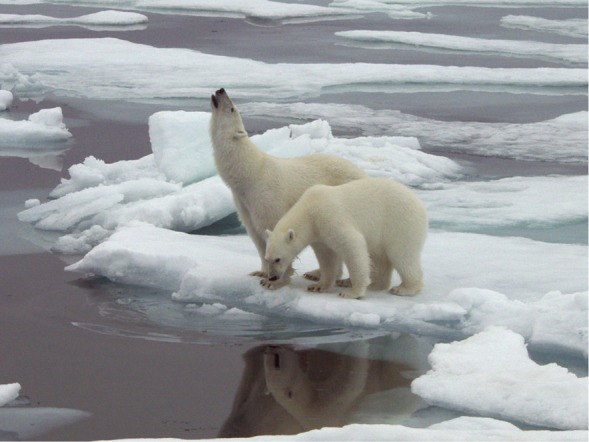
Polar Bear mother and cubs on ice-floes, separated by large areas of open water (© Tracey Dixon)
Figure 4 shows a mother black bear and her cubs hibernating. Her glazed expression is the result of her having been put to sleep with an anesthetic dart. Hibernating bears are easily arousable and tend to be somewhat grumpy when awakened, especially when they have cubs, as some biologists who study bear hibernation have discovered to their dismay. Like all bears that hibernate, polar bears are essentially immobile for 5-7 months or more, and yet they don’t get osteoporosis, the loss of bone mass, which every other mammal, including human beings, gets as a result of prolonged immobility. We would lose a third or more of our bone after 5 months of being bed ridden for example. All the time there is a dynamic process going on where cells called osteoblasts are making new bone, and other cells called osteoclasts are resorbing bone, so that bone architecture is constantly being remodeled. Under conditions where there is no weight bearing, no muscles pulling on bone, the equilibrium shifts to one’s bones become thinner and weaker. Astronauts may experience this during space travel. Every mammal, even other hibernators like woodchucks and bats, lose bone mass during hibernation. But hibernating bears do not. Osteoporosis is a huge public health problem for the elderly, particularly, because of the role of estrogen, for post-menopausal women. Fully one third of women over 65 will have a vertebral fracture not caused by injury because of osteoporosis. We can do many things to reduce our risk, like take enough Calcium and Vitamin D in our food and in supplements, stay active and exercise regularly. We can also take medicines called bisphosphonates to reduce the amount of bone loss or to halt it, but we cannot put back new bone once it has been lost. Osteoporosis causes more than 70,000 deaths in the U.S. each year. Hibernating bears have compounds in their blood streams that may someday allow us to effectively treat, and possibly even prevent, this largely untreatable disease.
Figure 4.
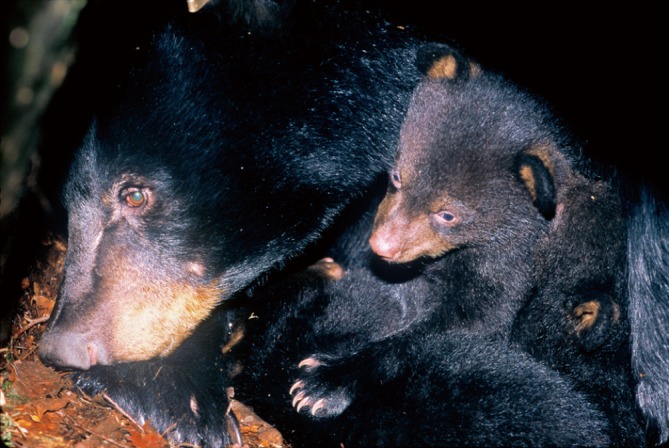
Mother Black Bear (Ursus americanus) denning with cubs (Photo by Gary Alt)
Bears also do not eat, drink, urinate, or defecate for the months they are hibernating, and yet they don’t become dehydrated, do not starve, and do not get sick from not urinating. If we do not urinate for a few days, we die. No one fully understands how bears do this, but somehow they are able to recycle their urinary wastes, break them down, turn them into amino acids, and make new proteins. More than 26 million Americans have chronic kidney disease, many of whom go on to kidney failure. There is no treatment other than dialysis and kidney transplantation for kidney failure, which kills more than 87,000 people each year in the U.S. alone, and costs our economy more than $35 billion annually. By studying hibernating bears, we may find ways of treating this dreaded condition.
Finally, polar bears become massively obese on seal blubber prior to hibernating, but they do not develop Type II diabetes, as we tend to do when we become obese. This is also not well understood. Obesity-related Type II diabetes, which is essentially epidemic in the U.S. and is expected to double or triple by the year 2050, now causes some ¼ of a million deaths each year in the U.S. The U.S. has the highest obesity rates in the world. In 2010, more than 35% of American adults and more than 17% of American children were obese. It is estimated that by 2015, some three quarters of the adults in the U.S. will be either overweight or obese, and that by 2050, as many as 1/3rd of American adults will have Type II diabetes.
With the loss of polar bears, which must be studied in the wild as bears do not hibernate in zoos, we may lose with them the secrets they hold that could allow us to treat, and perhaps even prevent, three largely untreatable diseases—osteoporosis, kidney failure, and obesity-related type 2 diabetes—that together kill some 400,000 Americans each year. That is what global warming and the melting of Arctic ice and the loss of polar bears in the wild really means for us.
Cone snails
Another example are cone snails (Figure 5). These marine organisms represent a large group of predatory snails that live in tropical coral reefs, mostly in the South-western Pacific Ocean. Cone snails defend themselves and paralyze their prey for food—worms, small fish, and other mollusks—by firing poison-coated harpoons at them (Figures 6,7).
Figure 5.
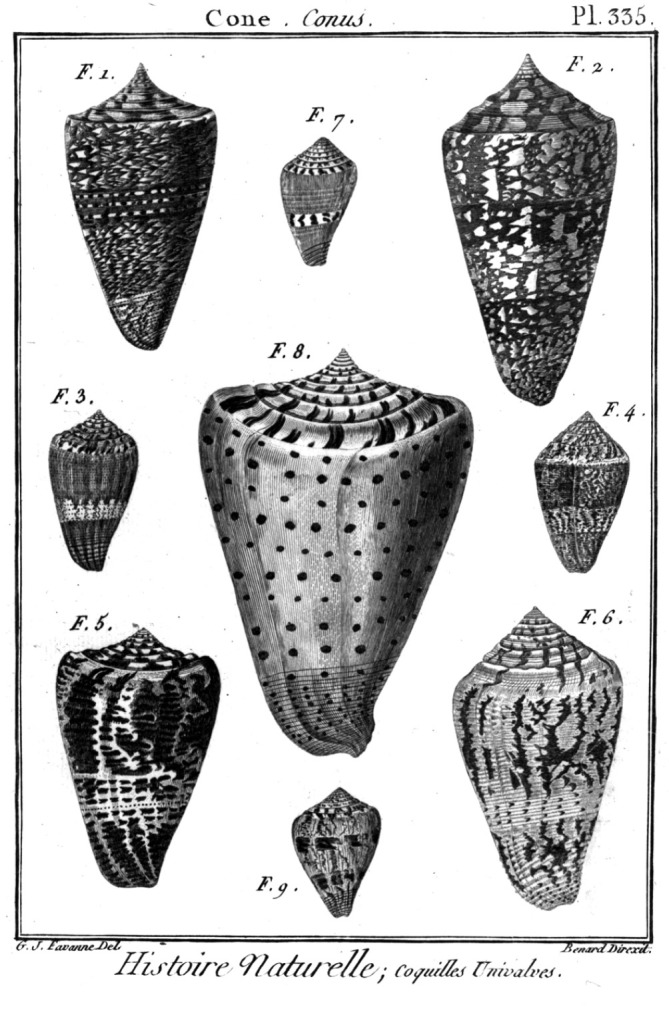
A collection of Cone Snail shells (from the 1798 Encyclopedia of Lamarck)
Figure 6.
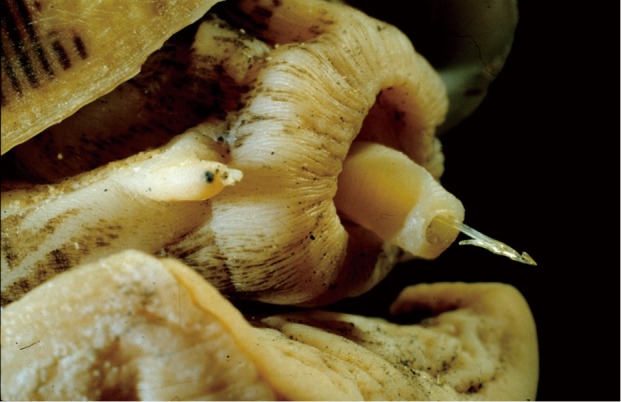
Close-up photo of Cone Snail harpoon protruding from its proboscis (© Clay Bryce)
Figure 7.
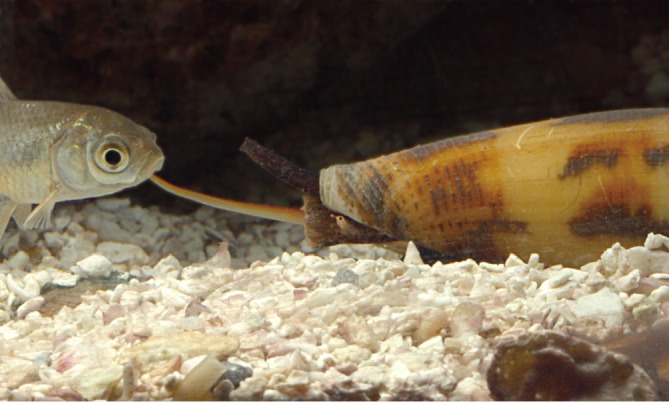
Conus striatus harpooning a fish (Courtesy of Baldomero M Olivera)
There are around 700 cone snail species and each species is believed to make 100-200 distinct toxic compounds to coat their harpoons, so there may be as many as 140,000 cone snail poisons in all. This is an explosion in evolution. Cone snail poisons are small proteins called peptides and are similar to the poisons of snakes, scorpions, sea anemones, and spiders, but in contrast to the poisons in these other creatures, cone snail peptides are much more numerous and are thought to target, with greater selectivity, a much larger number of molecular receptor sites on the membranes of all animal cells. Because these sites regulate the action of all cells, like heart cells or nerve cells, cone snail toxins have been intensively investigated to look for new medicines. Only about 6 species out of 700 and about 100 of the peptides out of perhaps 140,000 have been studied in any detail, and already several important potential new medicines have been found.
One, called Prialt, is currently on the market and is being used for the treatment of severe chronic pain that is not responsive to opiates. Prialt is 1,000 times more potent than morphine, but unlike morphine, it does not cause addiction or tolerance. Tolerance is that state where one has to keep giving more medication to achieve the same effect, and it is the tolerance that people develop over time to opiates like morphine that has limited their effectiveness and that has resulted in great human suffering. Eventually, one reaches a level where the opiate no longer works or where it may result in dangerous side effects like depressed respirations. As we speak, millions of people around the world are in agony from severe chronic pain—from cancer, from HIV/AIDS, from severe injuries, which cannot be helped by opiates. The discovery of Prialt, from a cone snail, is the beginning of a new era in medicine, the first highly effective medicine for pain that does not cause tolerance.
Other cone snails toxins are in clinical trials—for protecting nerve cells from dying during a stroke or head injury, for protecting heart cells during heart attacks, for epilepsy, and for other conditions. Some believe that cone snails may lead to more important human medicines than any other group of organisms on Earth. But cone snails largely inhabit coral reefs, two thirds of which are now threatened, mostly from global warming and acidification of the oceans. That is what losing coral reefs means; that is what we face with our ever-increasing release of greenhouse gases into the atmosphere.
Gastric brooding frog
Amphibians are among the most threatened group of organisms, with some one third of the almost 7,000 known species at risk of extinction. An example is an incredible frog, the Gastric Brooding Frog (Figure 8).
Figure 8.
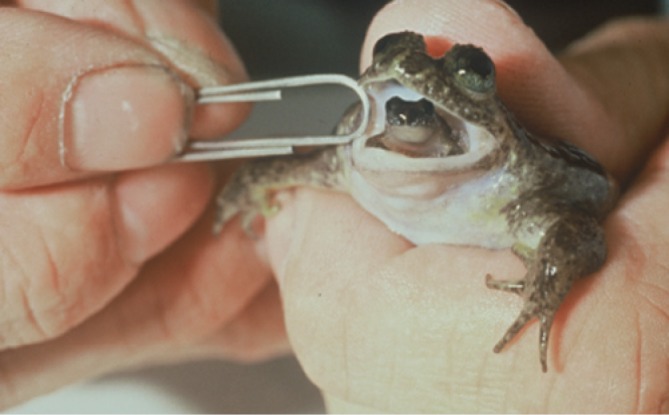
Gastric Brooding Frog (Rheobatrachus silus). Tadpole being delivered from mother’s stomach (© Michael J. Tyler)
Two species of gastric brooding frogs were discovered in rainforests in Australia. The female swallows the fertilized eggs, which then hatch in her stomach. There they develop into tadpoles and when they reach a certain stage of development, their mother vomits them into the outside world where they continue their development into adulthood. All vertebrates, including amphibians and humans, produce substances that regulate the release of acid and enzymes to begin the digestion of food in the stomach and to trigger the emptying of the stomach contents into the intestine. But it was discovered that the eggs and the newly hatched tadpoles of gastric brooding frogs secreted a substance, or substances, that inhibited the digestive process and prevented the stomach from emptying, substances that may have led to new insights for preventing and treating human peptic ulcer disease, a disease that afflicts more than 25 million people in the U.S. alone. But the studies that were underway to characterize these compounds could not be continued, because both species of gastric brooding frogs, the only ones ever discovered on Earth, went extinct, most likely from destruction of their forest and stream habitat and from climate change. And the miraculous chemicals that evolved in these frogs, which may not be found in other organisms, chemicals that could have provided more effective peptic ulcer treatments are now gone forever! And we may never know what these compounds were or how they worked.
Pacific Yew Tree
The following two examples are related to deforestation. The first is about the Pacific Yew Tree or Taxus brevifolia (Figure 9).
Figure 9.
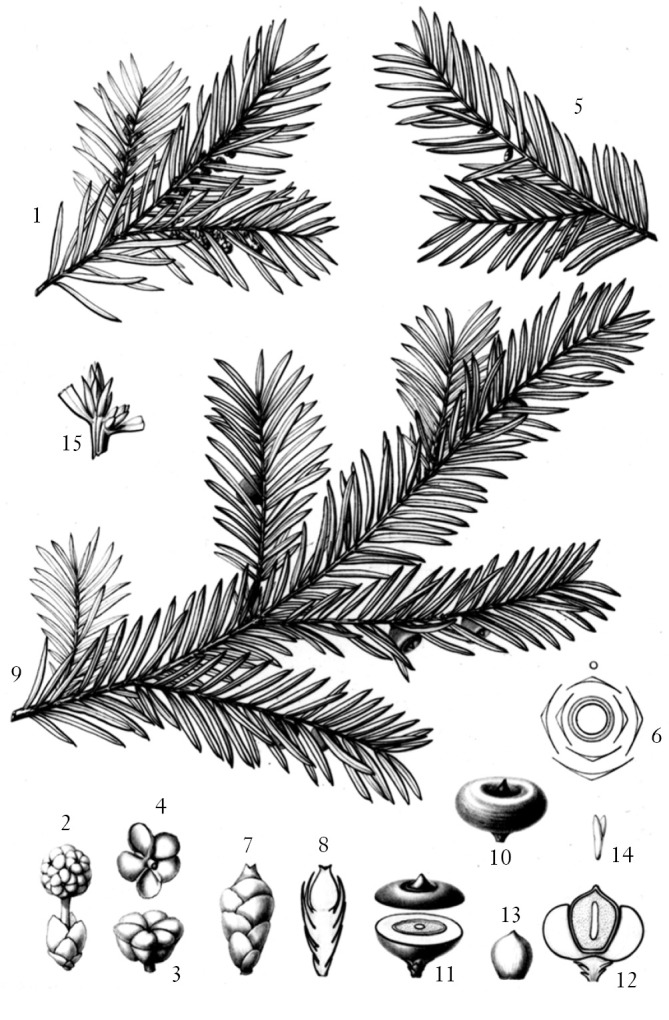
Pacific Yew tree (Taxus brevifolia) needles and cones (From Charles Sprague Sargent’s Silva of North America. Vol. 10. Houghton, Mifflin & Co.. Cambridge, 1896. Used with permission from the Harvard University Botanical Library)
Figure 9 shows the needles, cones, and berries of the Pacific Yew Tree. This tree, found in old growth forests of the Pacific North West, was routinely burned and discarded during logging operations for trees like tall, straight Douglas Firs, because the Yews were thought to have no commercial value. But in 1969, during a massive screening project of plants in the U.S. by the National Cancer Institute in cooperation with the USDA to find cancer medicines, a highly complex ring compound called Taxol, that synthetic chemists could not have designed (there are 2 to the 11th possibilities) was found in the bark of the Pacific Yew. Taxol was shown to have very potent activity against ovarian cancer cells. Ovarian cancer is notoriously hard to find and difficult to treat. My mother died from this cancer, as do close to 14,000 woman each year in the U.S. Taxol, and its semi-synthetic forms, alone or in combination with other agents, have become today the most effective therapeutic medications available for advanced ovarian cancer and for malignancies of the lung, prostate, breast and other organs. Taxol was the first drug that grossed over $1 billion. In 2000, Bristol Myers Squibb reported Taxol sales of $1.6 billion.
Taxol was found to work by a mechanism that was different from all other known chemotherapeutic agents, blocking the breakdown of the mitotic spindle, necessary for cell division in cancers and other cells (Figure 10). The discovery of Taxol has been miraculous in itself, but it has also led to a whole new class of cancer agents, that employ this previously unknown mechanism, some of which are even more effective than taxol.
Figure 10.
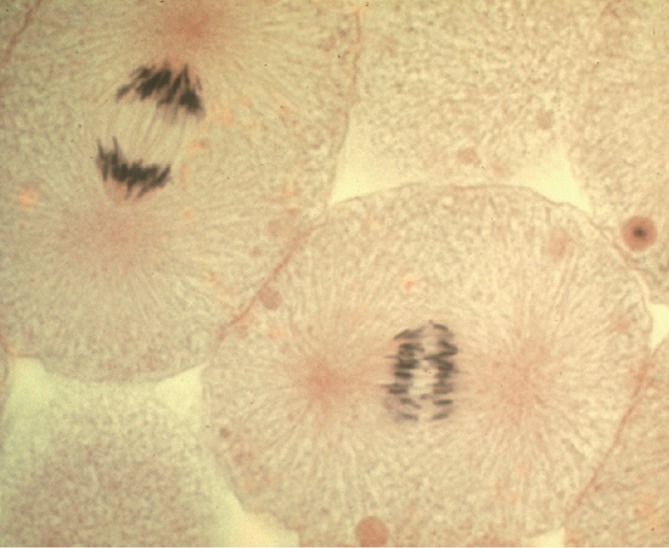
Cell division - metaphase - showing divided chromosomes attached to the mitotic spindle
Taxol is also used to coat coronary stents, where it prevents restenosis, the condition where the cells lining the arteries re-grow over and into the stent, shutting down blood flow (Figure 11). Taxol prevents these cells from dividing, another enormously valuable boon to medicine that has saved countless numbers of lives.
Figure 11.
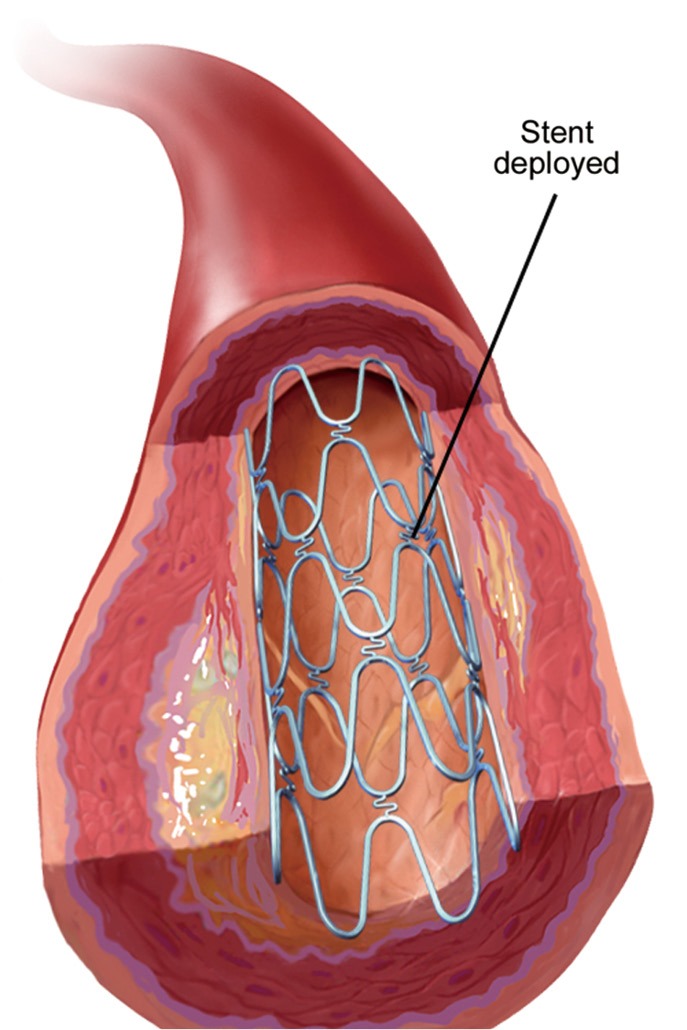
Coronary stent
The story of taxol illustrates that we may be losing other miraculous drugs with deforestation, not only in tropical rainforests, but in our own temperate forests in the U.S. and in other countries as well.
Lyme disease
Finally, let me talk about biodiversity and a human infectious disease, Lyme disease.
Lyme disease is the most common vector-borne disease in the U.S., causing some 20,000 cases each year. There are also likely to be a very large number of cases that are missed and not recorded, because the symptoms of Lyme disease resemble a bad flu, the ticks are very small and hard to see and may not cause a local skin reaction, the classic ‘bulls eye’ rash of Lyme appears in about 75% to 80% of people, and the blood tests are often negative early on. If left untreated, Lyme can result in serious chronic health problems, with effects on joints, the nervous system, and the cardiovascular system.
It was noticed that in some parts of the country where there was little vertebrate diversity, there was more Lyme disease, and some elegant research by my friend Rick Ostfeld and his colleagues at the Cary Institute of Ecosystem Studies in Millbrook, NY demonstrated why this may be so. Lyme is a complex disease involving the infectious agent, a bacterium named Borrelia burgdorferai, the transmitter of the bacterium, the black-legged tick (Figure 12), also called the deer tick in the Eastern U.S., and the hosts that support the proliferation of the pathogen and its passage to another host.
Figure 12.
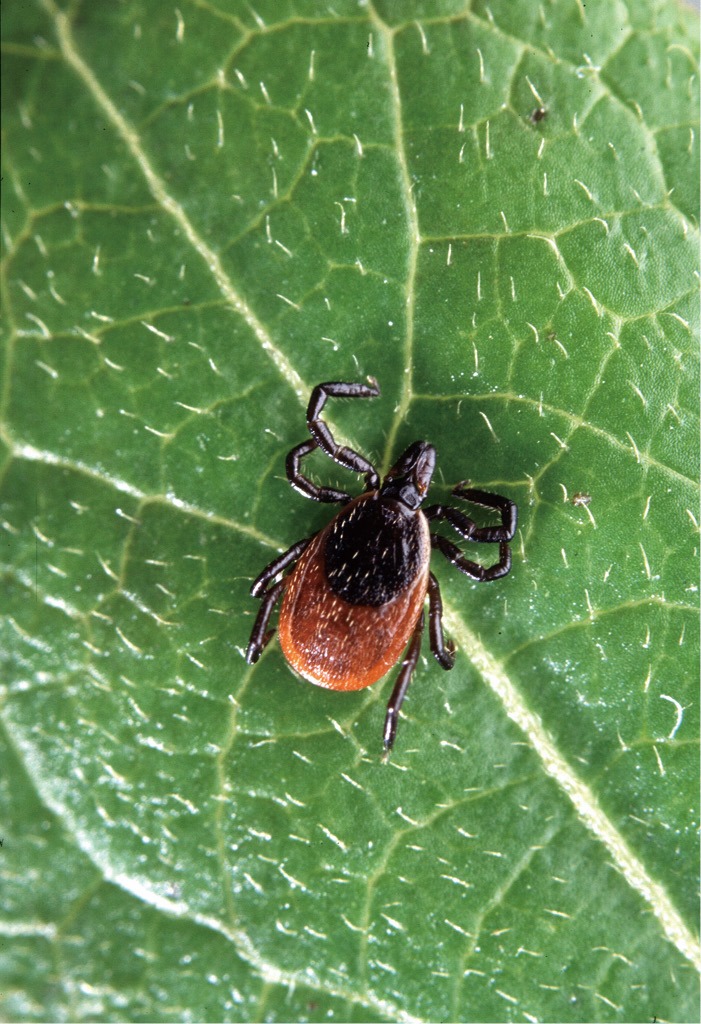
Blacklegged Tick (Ixodes scapularis) (Courtesy of Scott Bauer, U.S. Department of Agriculture)
In the East, the most important host is the white-footed mouse (Figure 13). Humans are a dead-end host, that is, we can get Lyme disease, but we do not pass it onto other organisms when ticks bite us and then bite other animals. We are what is called an incompetent host. It turns out that ticks are omnivorous feeders and they bite any animal that crosses their path in search of a blood meal. They will bite us, our dogs and cats, other rodents like chipmunks or squirrels, birds, and even reptiles. Many of the animals ticks bite, like us, are incompetent hosts. So if there is a lot of vertebrate diversity, then there are a lot of incompetent hosts for ticks to bite, hosts that do not pass on the Lyme infection. The result is that Lyme bacteria become diluted in hosts that do not pass it on, and therefore it is less likely for ticks to become infected in these regions, and for them to pass the disease onto people.
Figure 13.
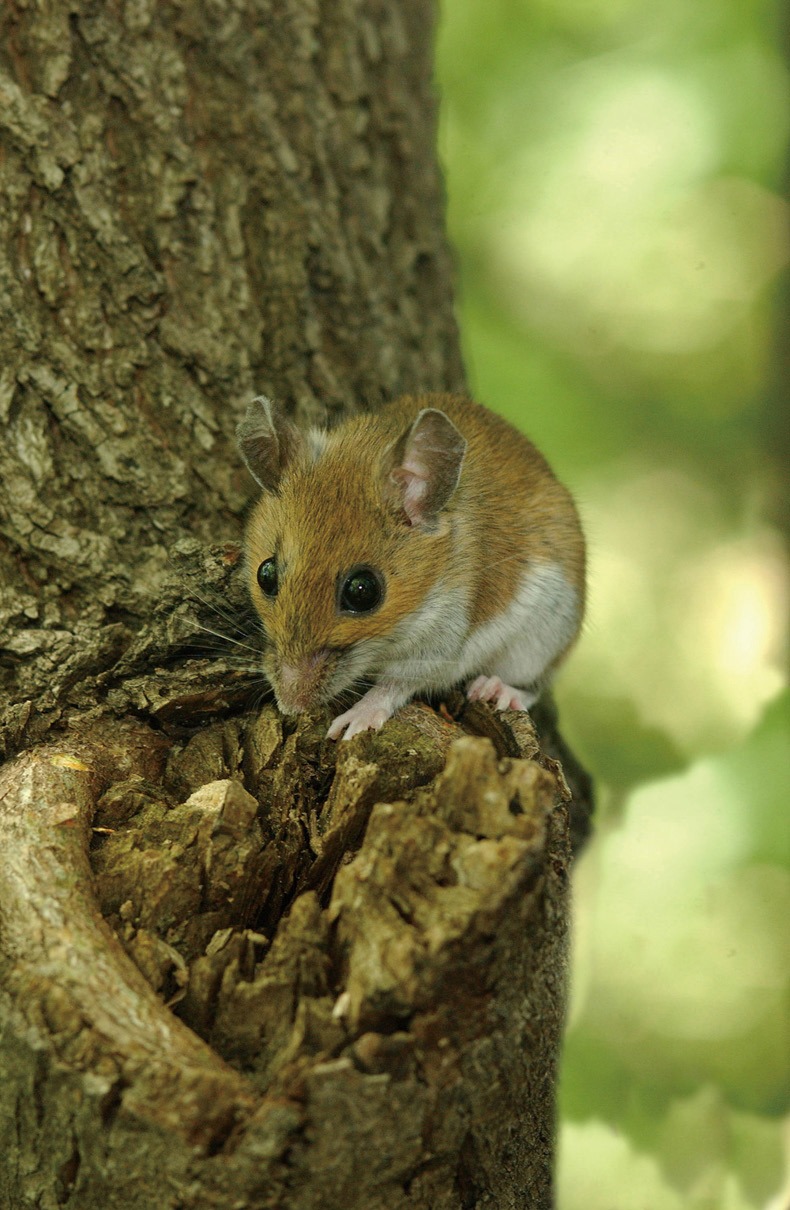
White-Footed Mouse (Peromyscus leucopus), the most competent reservoir for Lyme disease in the eastern U.S. (© Jim Schulz/Chicago Zoological Society)
There is another mechanism that keeps infection rates lower for us when there is greater vertebrate diversity, and that is there are more animals competing with white-footed mice for food, like other rodents, and there are more animals that eat white-footed mice, like foxes and hawks and weasels and bobcats, which eat the mice like Godiva chocolates, all of which results in reduced white footed mouse populations. With low populations of white-footed mice in these forests, there is less of a chance for people to become infected with Lyme. The diversity of vertebrates serves as a buffer for our getting a serious infectious disease.
The fragmentation of forests in the U.S. into small patches is one of the main reasons for a loss of vertebrate diversity, which then increases the risk of our getting Lyme disease. Figure 14 is a photo of severe forest fragmentation around Bear Lake, in Maine.
Figure 14.
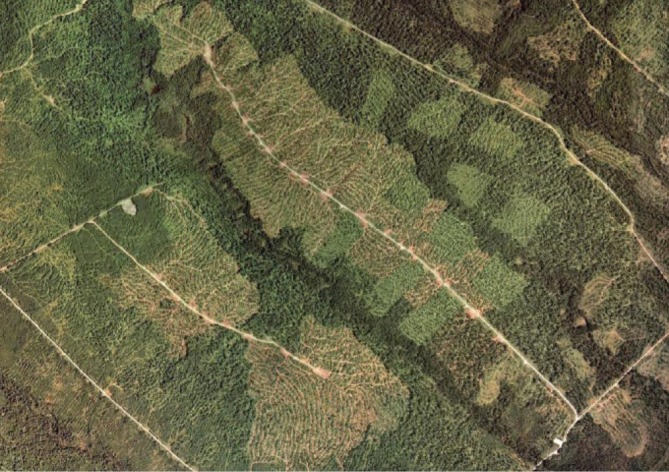
Forest fragmentation in Bear Lake, Maine (USDA Farm Service Agency)
Finally, climate change leads to warmer winters that may allow ticks to survive in areas where they previously died from the cold. Figure 15 shows a 10 fold increase in Lyme disease during this past decade in Maine, with cases moving from the warmer coast, northward and inland, and with increased rates of disease.
Figure 15.
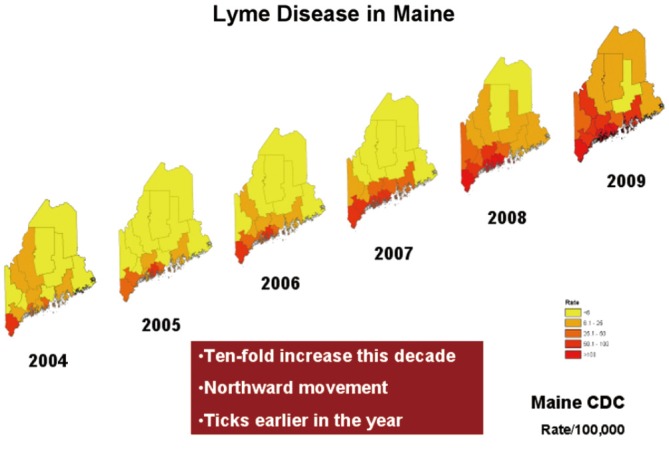
Lyme Disease spreading in Maine (from Paul R. Epstein, based on Maine CDC data)
The medical model—evidence and proof
The above examples describe the impact of climate change in the context of human health and disease, i.e. a ‘medical model’. I would like to discuss the role of evidence and “proof” in medicine and how this scientific approach could provide models for helping people understand the risks of our altering the global environment.
In making a medical diagnosis, physicians rely on genetics, the present and past history, a physical exam, lab tests, and imaging studies like X-rays, CT or MRI scans. Unlike in basic science where one tries to prove a hypothesis, in clinical medicine, it is rarely possible to have enough evidence to establish a proof, before one has to act. Decisions are made based on an accumulated body of evidence (what is commonly called ‘evidence-based medicine’), and the urgency of making them is based on the degree of risk involved. The greater the risk, the less evidence one relies on before making a decision. This is what is called the “precautionary principle”. In medicine, it is not an abstract scientific idea, it is something physicians must deal with everyday. Let me give you an example.
If a child less than one month old shows up at the hospital with a fever of more than 100.4 degrees F, or 38 degrees Celsius, he or she is immediately put on two broad spectrum antibiotics after blood, urine, and cerebrospinal fluid (the fluid that bathes the brain and spinal cord) are drawn for bacterial cultures. One does not wait until the cultures come back two days later before starting treatment, one cannot afford to wait, for in that time, a bacterial infection could spread rapidly through the infant’s body and kill it. More than 90% of fevers in infants are, in fact, caused by viruses, not bacteria, and only a small fraction of those that are caused by bacteria go on to cause serious problems or death. But the risk of not starting antibiotics immediately on all of the infants with high fevers is much too great, for by not doing so, one takes the risk that one or more of them will become dangerously ill and may die. That is a risk no physician is willing to take.
This is the model we need to use for making decisions about reducing greenhouse gas emissions and for addressing other assaults on the global environment. The risks of inaction and delay are so enormous, so potentially catastrophic for the planet, not just for now, but for hundreds and perhaps for thousands, and perhaps even for tens of thousands of years to come (in the case of the melting of Greenland and the Antarctic and the acidification of the oceans), that to wait to act until we have absolute proof, absolute certainty of what will happen, is to take a risk with the physical, chemical, and biological systems of the planet, to do a global experiment with our own health and our lives, that no member of congress, no mayor, no president, that no-one should ever be willing to take. This is the lesson of medicine and the medical model.
Conclusions
Figure 16 shows an image that was taken by the Voyager I Spacecraft on Feb. 14th, 1990, with the Earth over 4 billion miles away. At the suggestion of Carl Sagan, NASA directed Voyager to turn around and photograph the planets of the Solar System. One image showed what Sagan called “the pale blue dot” of the Earth, here enlarged.
Figure 16.
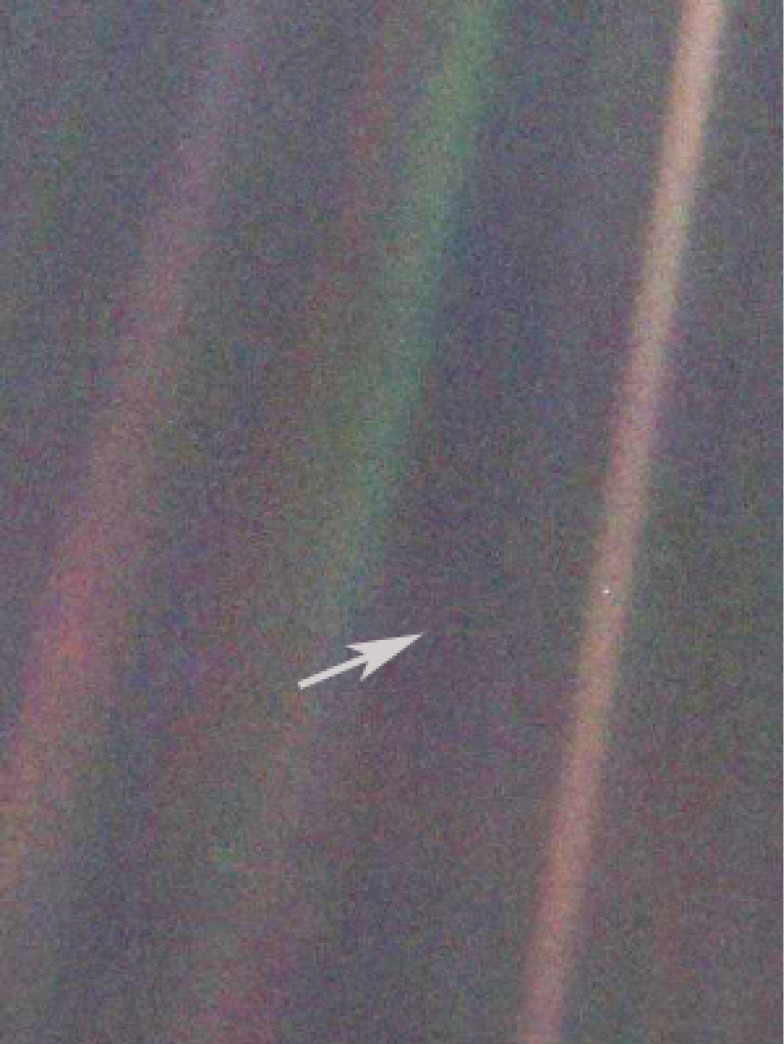
Voyager I ‘pale blue dot’
Carl Sagan, whom I was lucky enough to know and to have considered a friend, and who died tragically at a very young age, said the following about that pale blue dot:
“Look at that dot. That’s here. That’s home. That’s us. On it everyone you love, everyone you know, everyone you ever heard of, every human being who ever was, lived out their lives. The aggregate of our joy and suffering, thousands of confident religions, ideologies, and economic doctrines, every hunter and forager, every hero and coward, every creator and destroyer of civilization, every king and peasant, young couple in love, mother and father, hopeful child, inventor and explorer, every teacher of morals, corrupt politician, and “superstar”, every “supreme leader” every saint and sinner in the history of our species lived there—on a mote of dust suspended in a sunbeam.
The earth is a very small stage in a vast cosmic arena. Think of the rivers of blood spilled by all those generals and emperors so that, in glory and triumph, they could become the momentary masters of a fraction of a dot. Think of the endless cruelties visited by the inhabitants of one corner of this pixel on the scarcely distinguishable inhabitants of some other corner, how frequent their misunderstandings, how eager they are to kill one another, how fervent their hatreds. Our posturings, our imagined self-importance, the delusion that we have some privileged position in the Universe, are challenged by this point of pale light. Our planet is a lonely speck in the great enveloping cosmic dark. In our obscurity, in all this vastness, there is no hint that help will come from elsewhere to save us from ourselves.
The Earth is the only world known so far to harbor life. There is nowhere else, at least in the near future, to which our species could migrate. Visit, yes. Settle, not yet. Like it or not, for the moment the Earth is where we make our stand.
It has been said that astronomy is a humbling and character-building experience. There is perhaps no better demonstration of the folly of human conceits than this distant image of our tiny world. To me, it underscores our responsibility to deal more kindly with one another, and to preserve and cherish the pale blue dot, the only home we’ve ever known.”
I want to end this text with these thoughts. I believe that the changes to the environment I have described are caused by our own behavior, and that our generation and especially those of us in the richest, most powerful nations on the planet, have the ability, and the responsibility, to turn them around. I therefore urge the medical profession to learn as much as possible about what is happening to the global environment, and to use its enormous creativity, intelligence, energy, and resources to speak out, to become involved, and to do everything in its power to preserve this wondrous living world, this indescribably beautiful and precious gift we have all been given. I hope that this article contributes to this goal.
Acknowledgements
This manuscript is based on a talk given by the author to the Massachusetts Land Conservation Trusts and Environmental Agencies in Harvard Forest, Petersham, MA. The author is particular grateful to Bob Wilbur from Mass. Audubon for the invitation.
The opinions expressed in this article are those of the author, and not necessarily those of the Center for Health and the Global Environment at the Harvard School of Public Health or the publisher.
Disclosure: The author declares no conflict of interest.
References
- 1.Chivian E, Bernstein A. Sustaining Life: How Human Health Depends on Biodiversity. New York: Oxford University Press, USA; Ill edition.2008. ISBN-10: 0195175093, ISBN-13: 978-0195175097. [Google Scholar]
- 2.Leaf A.Potential health effects of global climatic and environmental changes. N Engl J Med 1989;321:1577-83 [DOI] [PubMed] [Google Scholar]


